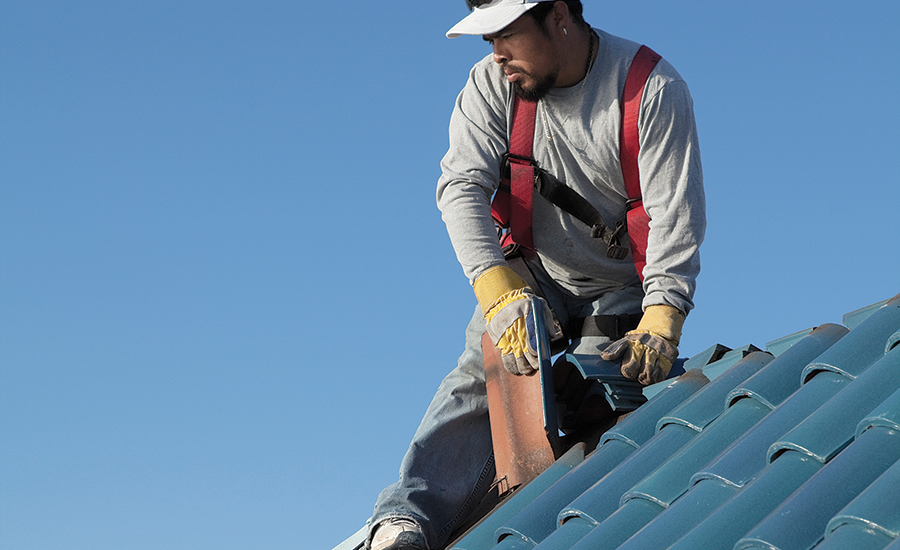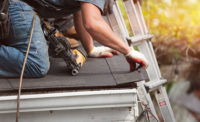Installing and repairing roof systems is difficult work that requires skill and craftsmanship to protect a building from the elements. What makes it even more challenging is that the work must be performed at elevation where workers are exposed to unprotected roof edges, unguarded skylights and hatches and roof decks that may not have the structural integrity to hold workers, material and equipment.
The latest numbers on workplace fatalities from the U.S. Bureau of Labor Statistics (BLS) show that 66 roofing company employees died from falls in 2013, up from 65 in 2012 and 61 in 2011.
Know your regs
Fall protection in the roofing industry is determined in those states under federal OSHA jurisdiction by the provisions found in Subpart M, Fall Protection, 29 CFR 1926.500-503. Most state plan states, that is, states that administer their own occupational safety and health program, have incorporated those same federal fall protection regulations and specific fall-protection control systems into their rules for worker protection. State plan states such as California, Kentucky, Oregon and Washington have unique fall protection requirements that differ significantly from the federal rules. In some states, broader fall-protection system options for workers are available for a contractor to select based on the nature of the work and the hazards faced.
OSHA construction regulations apply to work done under a contract for construction, alteration or repair. Construction workers generally are required to have fall protection when they are exposed to falls of six feet or greater. OSHA general industry rules cover most other workers in manufacturing, warehousing and other business classifications and mandate fall protection when workers are exposed to fall hazards of four feet or greater.
Conventional fall protection
Generally, roofing workers on low-sloped roofs (4:12 or less) must be protected from falls at heights of six feet or greater by guardrail, safety net or personal fall arrest systems (PFAs)―often called ”conventional” fall protection. Conventional fall protection systems also are required to protect other workers covered under the construction regulations. However, OSHA rules applicable to roofing work on low-slope roofs also allow a warning line system in combination with one of the conventional fall protection systems or a warning line and safety monitoring system to be used to protect workers from falls. On roofs 50-feet wide or less, a safety monitoring system alone may be used.
Defining “roofing work”
A critical factor in the use of those fall protection systems not considered conventional under OSHA rules is that the work being done must fall within the definition of “roofing work.” OSHA defines that as:
…the hoisting, storage, application, and removal of roofing materials and equipment, including related insulation, sheet metal, and vapor barrier work, but not including the construction of the roof deck.
If work taking place on a low-slope roof does not fall within the definition of roofing work, only conventional fall protection may be used to protect workers at heights of six feet or greater. On steep-slope roofs (greater than 4:12 pitch), only conventional fall protection may be used to protect workers without regard to the whether the work being performed meets the definition of roofing work. For steep-slope roofing, PFAS tend to be the fall protection system of choice for most roofing contractors with workers required to use rope grabs and lifelines or self-retracting lifelines (SRLs). Some innovative equipment manufacturers have designed guardrail systems that can be installed relatively easily at the eave and rake edges of steep-slope roofs with brackets that may be adjusted so that guardrail posts are most effective in stopping a falling worker.
However, on some residential steep-slope buildings, other fall protection measures may be employed under the auspices of a written fall protection plan if a contractor shows that conventional fall protection is infeasible or creates a greater hazard. There is a presumption that conventional fall protection is feasible and will not create a greater hazard and the contractor accordingly has the burden of establishing that the controls provided under a fall protection plan are appropriate.
Sad reality
The quality of fall protection equipment and systems available today in roofing and construction has never been better. Manufacturers of such specialized equipment have made it safe, effective and affordable.
Unfortunately, a recent review of OSHA inspection data from jobsites where a roofing worker fatality has occurred shows that in the majority of instances NO fall protection system at all was being used to protect the worker who subsequently died.
In 138 of 153 incidents during the 2004-2008 period that inspection reports were studied, OSHA makes no mention in the report of a specific fall protection system in place or states directly that no fall protection was being used at the time of the incident. Equally disheartening, in 11 of the remaining 15 fatalities, workers were using PFAs but had disconnected from the anchor point or lifeline rendering the system ineffective and ultimately causing the death.
Going forward
The release of BLS workplace fatality numbers is always a sobering event and it reflects the vast amount of work that we all must do to try to make the roofing workplace safer.
Roofing contractors must commit to developing a culture of safety at their company to ensure that workers are protected during all phases and aspects of a roofing project. This starts with performing job hazard analyses of projects so that each particular dangerous situation is identified and proper controls are applied. Often proper controls may mean that unique or new fall protection systems are purchased and implemented or that established systems are reviewed for effectiveness.
An essential part of that process is comprehensive worker training in the fall hazards that they will encounter and the fall protection equipment they will be using. Deficiencies in worker training and failing to audit workplaces to ensure compliance are often precursors to a fatal or serious injury event—a sad example being workers who died while using PFAs that were unhooked from anchor points.
With the support of OSHA, the National Roofing Contractors Association (NRCA) delivers free fall protection training for workers throughout the U.S., focusing on fall hazards and controls workers must employ to minimize or eliminate the risk of injury or death.
Resources
In addition, NRCA has recently updated two of its safety publications, NRCA Toolbox Talks and NRCA Pocket Guide to Safety to include the most current safe work-place practices for roofing professionals. To learn more go to www.nrca.net.
Everyone in the roofing industry looks forward to the day when contractor and worker compliance with fall protection requirements is reflected in a downward trend of BLS fatality statistics with regard to falls from roofs.

